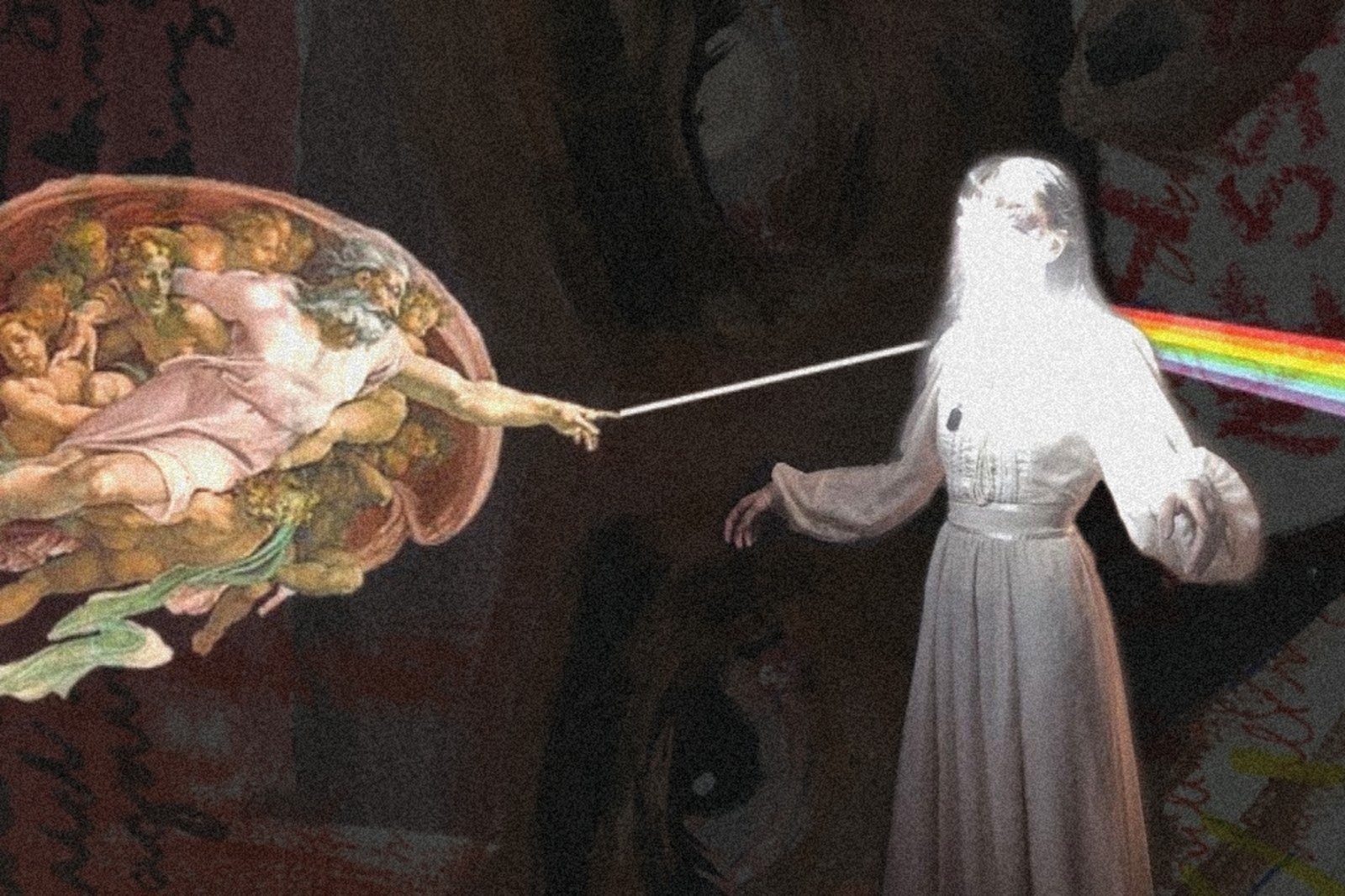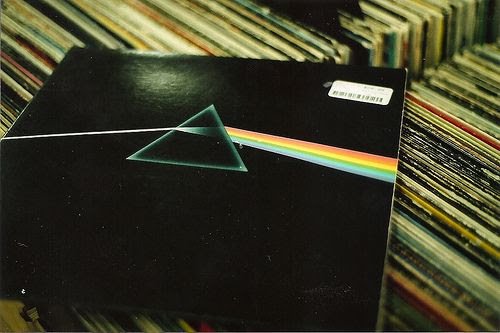The Concept Behind The Concept Album
By Ayesha Ali
It's November 2019. Before time slips into its three-year coma, it succumbs to winter first, and my friends and I wait shivering in the London cold for a Norwegian singer’s show. Meanwhile, a man with a megaphone spouts nonsensical bullshit across the street, projecting his voice like a passionate preacher who won’t leave you alone. He almost ruins the mood before we are finally ushered inside after an unnecessarily long security check and some confusion as to where to go. Then we’re in.
The venue is small, intimate, and beautiful. Violet specters of light rain down onto the floor, illuminating different faces and bodies. The audience shed their coats, soaking in the inviting warmth and gazing up at the empty stage while they talk excitedly about the woman who’s to grace us with her enigmatic presence. Her story is one we’ve all already familiarised ourselves with, but we’re waiting for it to be made real. The anticipation in the enclosed space isn't claustrophobic; it's endearingly communal.
Aurora arrives, her voice is soft but passionate as she gifts the audience with an amusing anecdote about a toothless stranger she'd met some days ago. She punctuates the silences between each song like this, and, with or without knowing it, she's humanized herself beyond the dreamy songwriter she's known as.
She performs, and I feel harmonies building up like bile in my throat, their sharp-tasting intensity running on sheer adrenaline. I’m close enough to see sweat plastering Aurora’s hair to her brow, the exertion in every earnest lyric. There’s a whimsy that I haven’t felt since the summers of my childhood as the crowd fuses together into one writhing being, arms stretched upwards like flowers reaching for sunlight. It’s befitting of her latest album at the time, about the bond between nature, humanity, and empathy. A wild laugh escapes me; I've never felt more alive.
Concept albums have always been my favourite kind of music to listen to. Raised on the kiccha my dad regaled me with before bedtime, tales rooted in the rich traditions of Bengali folklore, instilled in me a deep appreciation for storytelling. When I discovered that my favourite musicians were crafting their own stories through music, I was captivated.
My dad was also my initial introduction to music. The first song through which I discovered I loved to sing was in Bengali. The Eagles' Hotel California would waft its way out from the car radio during long journeys, its twanging guitar solos harmonizing with the summer breeze. Dad would comically belt out the chorus of Bryan Adams' (Everything I Do) I Do It For You as my sister and I laughed along. Legendary bands of the 70s and 80s like Bon Jovi and Pink Floyd were also part of his university days' punk soundtrack. So I decided to steal his music taste and take a page from his book.
Pink Floyd had already established themselves as an experimental rock band popular with university students like us. It was The Dark Side of the Moon that catapulted them to critical acclaim and recognition. The album effortlessly connects the themes of time, modern consumerism, and madness in its introspective opener Speak to Me. Its rhythmic heartbeat quickly disintegrates into the relentless ticking of clock hands and the noise of a cash machine. Conversation about being "mad for fucking years" echoes, concluding with a manic laugh and Clare Torry's iconic musical wail. In just over a minute of musical chaos, these themes are masterfully woven together.
Modern consumerism resurfaces in Breathe (In the Air), with lyrics underscoring the importance of living life to the fullest despite the inevitability of death. The band realized living life in the fast lane isn't the healthiest choice through their rock 'n' roll lifestyle. However, one of the pros is profit, eloquently discussed in Money. There’s the allure of higher-paying jobs and the begrudging acceptance of a capitalist culture that celebrates The Hustle. Money is "the root of all evil today," affecting both the affluent and the working class. Any Colour You Like is welcoming with pleasant, warbling synths and a staccato guitar solo. While the lack of lyrics may suggest freedom of choice, the real message lies in its illusion in a world of increasing scarcity and insatiable desires.
The album contends that we are not merely prisoners of our own desires but also slaves to time. On the Run amplifies the anxiety of daily life with frantic synths, airport PSAs, laughter, and laboured breathing. This tumultuous soundscape segues into Time, where the cacophony of clocks, alarms, and the persistent tick-tock serves as a stark warning against allowing time to dictate our lives before we've truly lived. The album concludes with Eclipse, offering an optimistic perspective on simply existing without the pursuit of perfection in all that we do.
Madness is DSOTM’s central theme, reflecting on mental health inspired by ex-member Syd Barrett. Speak to Me’s brevity and chaos evoke his brief and tumultuous career with Pink Floyd. The Great Gig in the Sky showcases Torry's powerful performance prefaced by gentle piano chords and guitar strums. In the studio version, people discuss whether they’re "frightened of dying," while the live rendition features Bible excerpts. It’s raw and unsettling. Us and Them looks at depression, a mellower contrast to the prior upbeat cynicism, exploring the prevalence of a previously misunderstood condition. Brain Damage directly references Barrett: "if the band you're in starts playing different tunes," alluding to his habit of diverging from his bandmates during performances due to his detachment from reality.
Preacher's Daughter marks Hayden Anhedönia's debut album under the moniker Ethel Cain, a genre-nonconforming work that boldly charters unsettling territory. Released through the artist's own record label, the album unfolds in the Deep South of the nineties, narrated by our protagonist Ethel Cain, daughter of a deceased yet revered preacher. It's a cautionary tale born from Hayden's deepest fears. Like DSOTM, this album is a journey of constant transformation, with each song representing a metamorphosis in Ethel's life.
Religious trauma is at the forefront, its album cover featuring Ethel beneath Jesus’ portrait. Family Tree (Intro) introduces the preacher before his sermon is interrupted by Ethel. References to Jesus, forgiveness, and the preacher all set the stage. Family Tree continues this with moody guitars and a tumultuous bridge, layered rhythm guitars, and Hayden's strung-out belt. Televangelism is an instrumental track, its reverberating piano eventually warping to symbolize the disingenuity of televised religion. Sun Bleached Flies still criticizes the manipulation of religion but does so with sincerity and heart. Backed by her own voice as a choir, Hayden sings "God loves you, but not enough to save you," a sentiment Ethel herself eventually accepts.
With lighthearted guitar melodies and upbeat pop sound, American Teenager cleverly disguises the misguided American Dream that devolves into an American Nightmare. This ode to disillusioned youth takes a personal turn in A House In Nebraska. It references an imagined sanctuary for young Ethel and her lover, poignantly embodying the pain of losing him with a heartrending guitar solo outro. Thoroughfare lures us into a false sense of hope, a jovial nine-minute country ballad before the sensual Gibson Girl. Referencing Charles Dana Gibson's depiction of the American feminine beauty standard, this track exposes Ethel's exploitation and shatters the illusion of escape in the previous song.
Violence is a potent theme in Preacher's Daughter, often perpetrated by the men in Ethel's life. Western Nights finds her on the run with a new lover, whose abuse she overlooks. Hard Times burrows into this, Ethel’s childlike voice unveiling her father's true nature. The climax is Ptolemaea, its doom metal sound, blood-curdling screams, biblical lyrics, and personification of death are all horrific-sounding. This intensifies in August Underground, its distorted sense of futility conveyed through Hayden's vocals. Strangers is a less gloomy exploration of postmortem violence as Ethel's killer cannibalizes her remains, maintaining its chilling narrative.
DPR Ian's Moodswings In To Order is a raw reflection of his experience with bipolar disorder and Dissociative Identity Disorder. Unlike the previous albums, this work doesn't neatly fit into defined themes or motifs. Instead, it's a self-aware album that vividly portrays the highs and lows of living with these conditions.
The album introduces Mito, an acronym from the album's title, representing the personality that serves as DPR Ian's guardian during dissociative episodes. Through the album's opener, Seraph, characterized by operatic strings, climactic synths, and thunderous soundscapes, Ian takes us on Mito's fall from grace, offering an emotional journey that words cannot convey. This powerful narrative continues in 1 Shot, a percussive and intense track.
A visually stunning short film directed and edited by Ian features Seraph, 1 Shot, Mood, and Ribbon. It explores the tumultuous nature of Ian’s mental state through vibrant colours and dynamic choreography, drawing from his K-pop background. However, the album itself delves deeper into the whimsical mental highs, often characterized by soft percussion and gentle synths, as heard in Avalon. The track’s title references the island of Arthurian lore, symbolizing both magic and dark sorcery, mirroring the duality of Ian’s creative manic highs and depressive lows.
Where the film’s tracks are fast-paced and darker in tone, Merry Go is a dreamy, slower approach to exploring the relationship between Mito and Ian. Blackouts during dissociation are referenced, with Ian assuming he “must have passed out last night” and is still “fumbling with [Mito’s] memories.” This amnesia isn’t fearful or dramatic, as peace between Ian and Mito is necessary if the singer wishes to live with his disorders.
Winterfall builds on this dreamlike sound, beginning with smooth acoustic guitars, a playful whistle, and Ian directly talking to Mito. It quiets down to whispering vocals in the bridge before dipping into echoing synths and a hazy instrumental outro. It’s a beautiful release from the darker-sounding tracks. However, as in Sometimes I’m, Ian’s “day goes down to up” and the album reflects this mental turbulence in later tracks, showing that a resolution has not been found.
Mr. Insanity explains that Ian “shot [him]self in the foot” despite his best efforts to reconcile himself with Mito. Ballroom Extravaganza is the album’s climax, as Ian’s world “came crashing down” through the inevitable fall from the precipice of a manic high. “When the story comes to an end, will you be the same again?” This is only touched on in the ending track Sometimes I’m, but will be answered in Ian’s future work.




